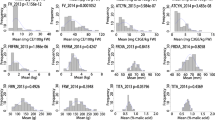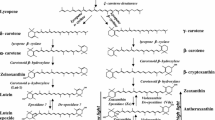Abstract
Quantitative trait loci (QTL) analysis of phenolic compound accumulation was performed in a broccoli mapping population (Brassica oleracea) saturated with single nucleotide polymorphism markers from an Illumina 60K array designed for rapeseed (Brassica napus). In 2 years of analysis in North Carolina and 1 year in Illinois, variation in total phenolic content and antioxidant capacity was associated with 60 QTL. Twenty-three of these loci were identified in at least two analyses (three phenolic/antioxidant assays times 4 years (2009, 2010, 2014, and the mean of the 3 years) making a total of 12 trait-year assays); the two most stable QTL (no. 7 and no. 52) were identified in six and five analyses, respectively. Genome-specific SNP markers were used to identify a priori candidate genes within the QTL marker intervals. Genes involved in the early stages of phenylpropanoid biosynthesis and MYB transcription factors were most heavily represented among the putative candidate genes. The results demonstrate the complexity of the regulatory network involved in phenolic compound accumulation, but highlight potential targets for the development of Brassica vegetables with enhanced phenolic compound profiles.
Similar content being viewed by others
References
Bergmann H, Triebel S, Kahle K, Richling E (2010) The metabolic fate of apple polyphenols in humans. Curr Nut Food Sci 6(1):19–35
Brown AF, Yousef GG, Jeffery EH, Klein BP, Wallig MA, Kushad MM, Juvik JA (2002) Glucosinolate profiles in broccoli: variation in levels and implications in breeding for cancer chemoprotection. J Am Soc Hortic Sci 127(5):807–813
Brown AF, Jeffery EH, Juvik JA (2007) A polymerase chain reaction-based linkage map of broccoli and identification of quantitative trait loci associated with harvest date and head weight. J Am Soc Hortic Sci 132(4):507–513
Brown AF, Yousef GG, Chebrolu KK, Byrd RW, Everhart KW, Thomas A, Reid RW, Parkin IA, Sharpe AG, Oliver R (2014) High-density single nucleotide polymorphism (SNP) array mapping in Brassica oleracea: identification of QTL associated with carotenoid variation in broccoli florets. Theor Appl Genet 127(9):2051–2064
Brown AF, Yousef GG, Reid RW, Chebrolu KK, Thomas A, Krueger C, Jeffery E, Jackson E, Juvik JA (2015) Genetic analysis of glucosinolate variability in broccoli florets using genome-anchored single nucleotide polymorphisms. Theor Appl Genet 128(7):1431–1447
Cheynier V, Comte G, Davies KM, Lattanzio V, Martens S (2013) Plant phenolics: recent advances on their biosynthesis, genetics, and ecophysiology. Plant Physiol Biochem 72:1–20
Clifford MN (2004) Diet-derived phenols in plasma and tissues and their implications for health. Planta Med 70(12):1103–1114
Crozier A, Jaganath IB, Clifford MN (2009) Dietary phenolics: chemistry, bioavailability and effects on health. Nat Prod Rep 26(8):1001–1043
Dinkova-Kostova AT, Massiah MA, Bozak RE, Hicks RJ, Talalay P (2001) Potency of michael reaction acceptors as inducers of enzymes that protect against carcinogenesis depends on their reactivity with sulfhydryl groups. Proc Natl Acad Sci USA 98(6):3404–3409
Forman HJ, Davies KJA, Ursini F (2014) How do nutritional antioxidants really work: nucleophilic tone and para-hormesis versus free radical scavenging in vivo. Free Radic Biol Med 66:24–35
Heimler D, Vignolini P, Dini MG, Vincieri FF, Romani A (2006) Antiradical activity and polyphenol composition of local Brassicaceae edible varieties. Food Chem 99(3):464–469
Hertog ML, Kromhout D, Aravanis C et al (1995) Flavonoid intake and long-term risk of coronary heart disease and cancer in the seven countries study. Arch Intern Med 155(4):381–386
Kim M, Choi S-, Lee P, Hur J (2015) Neochlorogenic acid inhibits lipopolysaccharide-induced activation and pro-inflammatory responses in BV2 microglial cells. Neurochem Res 40(9):1792–1798
Knekt P, Kumpulainen J, Jarvinen R, Rissanen H, Heliovaara M, Reunanen A, Hakulinen T, Aromaa A (2002) Flavonoid intake and risk of chronic diseases. Am J Clin Nutr 76(3):560–568
Ku KM, Choi JN, Kim J, Kim JK, Yoo LG, Lee SJ, Hong Y, Lee CH (2010) Metabolomics analysis reveals the compositional differences of shade grown tea (Camellia sinensis L.). J Agric Food Chem 58(1):418–426
Kushad MM, Brown AF, Kurilich AC, Juvik JA, Klein BP, Wallig MA, Jeffery EH (1999) Variation of glucosinolates in vegetable crops of Brassica oleracea. J Agric Food Chem 47(4):1541–1548
Lotkowska ME, Tohge T, Fernie AR, Xue G, Balazadeh S, Mueller-Roeber B (2015) The arabidopsis transcription factor MYB112 promotes anthocyanin formation during salinity and under high light stress. Plant Physiol 169(3):1862–1880
Luo J, Butelli E, Hill L, Parr A, Niggeweg R, Bailey P, Weisshaar B, Martin C (2008) AtMYB12 regulates caffeoyl quinic acid and flavonol synthesis in tomato: expression in fruit results in very high levels of both types of polyphenol. Plant J 56(2):316–326
Ma Q (2014) Advances in mechanisms of anti-oxidation. Discovery Medicine 17(93):121–130
Masella R, Di Benedetto R, Varì R, Filesi C, Giovannini C (2005) Novel mechanisms of natural antioxidant compounds in biological systems: involvement of glutathione and glutathione-related enzymes. J Nutr Biochem 16(10):577–586
Millar AA, Gubler F (2005) The arabidopsis GAMYB-like genes, MYB33 and MYB65, are microRNA-regulated genes that redundantly facilitate anther development. Plant Cell 17(3):705–721
Osburn WO, Kensler TW (2008) Nrf2 signaling: an adaptive response pathway for protection against environmental toxic insults. Mutat Res Rev Mutat Res 659(1–2):31–39
Parkin IAP, Koh C, Tang H, Robinson SJ, Kagale S, Clarke WE, Town CD, Nixon J, Krishnakumar V, Bidwell SL et al (2014) Transcriptome and methylome profiling reveals relics of genome dominance in the mesopolyploid Brassica oleracea. Genome Biol 15(6):R77
Price KR, Casuscelli F, Colquhoun IJ, Rhodes MJC (1997) Hydroxycinnamic acid esters from broccoli florets. Phytochemistry 45(8):1683–1687
Price KR, Casuscelli F, Colquhoun IJ, Rhodes MJC (1998) Composition and content of flavonol glycosides in broccoli florets (Brassica olearacea) and their fate during cooking. J Sci Food Agric 77(4):468–472
Quilichini TD, Samuels AL, Douglas CJ (2014) ABCG26-mediated polyketide trafficking and hydroxycinnamoyl spermidines contribute to pollen wall exine formation in Arabidopsis. Plant Cell 26(11):4483–4498. doi:10.1105/tpc.114.130484
Saito K, Yonekura-Sakakibara K, Nakabayashi R, Higashi Y, Yamazaki M, Tohge T, Fernie AR (2013) The flavonoid biosynthetic pathway in arabidopsis: structural and genetic diversity. Plant Physiol Biochem 72:21–34
Sotelo T, Cartea ME, Velasco P, Soengas P (2014) Identification of antioxidant capacity-related QTLs in Brassica olearacea. PLoS One 9(9):e107290
Sun CL, Yuan JM, Koh WP, Yu MC (2006) Green tea, black tea and breast cancer risk: a meta-analysis of epidemiological studies. Carcinogenesis 27(7):1310–1315
Tang N, Wu Y, Zhou B, Wang B, Yu R (2009) Green tea, black tea consumption and risk of lung cancer: a meta-analysis. Lung Cancer 65(3):274–283
Van Ooijen J (2004) MapQTL® 5. Software for the mapping of quantitative trait loci in experimental populations. Kayazma B.V., Wageningen
Weng C, Chen M, Yeh C, Yen G (2011) Hepatoprotection of quercetin against oxidative stress by induction of metallothionein expression through activating MAPK and PI3K pathways and enhancing Nrf2 DNA-binding activity. New Biotechnol 28(6):767–777
Acknowledgments
This research was supported in part by the Hatch Multistate Project NC-7 (ILLU-802-931). We kindly acknowledge Professor Ray Ming for the use of his QTL mapping software, Dr. Kang Mo Ku for his help with the antioxidant assays, and Dr. Talon Becker for assistance with field planting, harvesting, experimental design.
Author information
Authors and Affiliations
Corresponding author
Electronic supplementary material
Below is the link to the electronic supplementary material.
Rights and permissions
About this article
Cite this article
Gardner, A.M., Brown, A.F. & Juvik, J.A. QTL analysis for the identification of candidate genes controlling phenolic compound accumulation in broccoli (Brassica oleracea L. var. italica). Mol Breeding 36, 81 (2016). https://doi.org/10.1007/s11032-016-0497-4
Received:
Accepted:
Published:
DOI: https://doi.org/10.1007/s11032-016-0497-4




